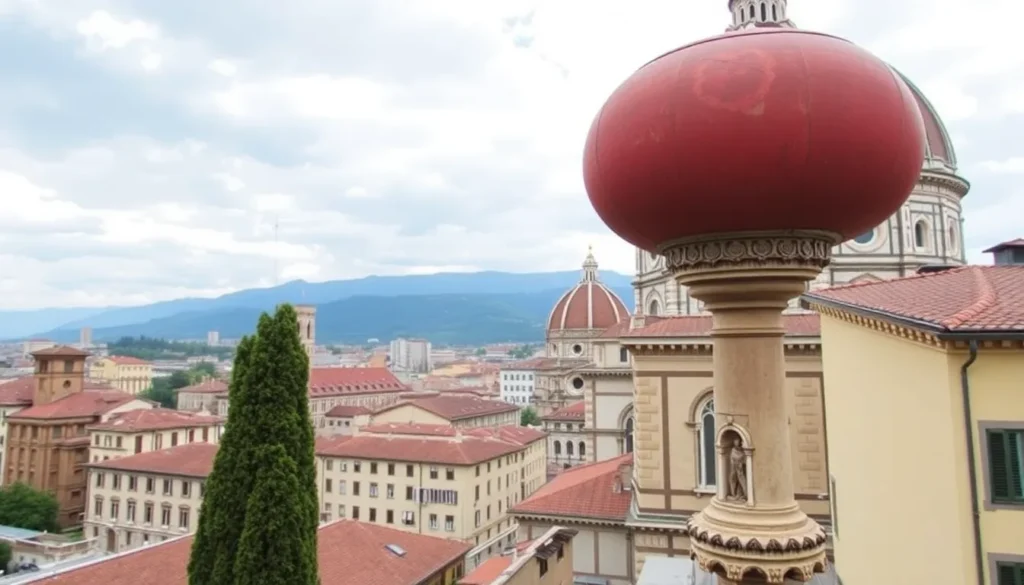20 fascinating facts about Florence you might not know

Florence is not just a city; it is a treasure trove of history, art, and captivating stories that transport you to another era. Walking through its streets feels like traversing an immense outdoor gallery where every corner reveals a new masterpiece. Known as the global capital of the Renaissance, Florence has been shaped by centuries of remarkable events, legends, and intriguing curiosities that make it a must-visit destination for any traveler. Let’s dive into some of the most fascinating facts about this enchanting city that you might not know!
- Rich History of Florence
- Florence: The Birthplace of Many Geniuses
- Leonardo Da Vinci: A Renaissance Man
- The Symbol of Florence: The Lily
- The Ponte Vecchio: A Bridge with a Heart
- The Majestic Dome of Florence
- Florence as Italy’s Former Capital
- The David by Michelangelo: A Monumental Task
- The Lucky Wild Boar of Florence
- More Fascinating Facts About Florence
Rich History of Florence
Florence has a storied past that dates back to the Roman Empire. Originally founded as a military outpost, it blossomed into a vibrant center for commerce and culture. By the 14th century, Florence was at the forefront of the Renaissance, fostering the talents of artists like Michelangelo and Botticelli. The city’s wealth, largely through the banking prowess of the Medici family, enabled it to become a hotspot for art, politics, and intellect.
Florence: The Birthplace of Many Geniuses
Florence has been home to some of history's most brilliant minds. Notable figures include Leonardo da Vinci, who, although born in the nearby town of Vinci, spent much of his life in Florence, and Dante Alighieri, the father of the Italian language. Their contributions continue to influence art and literature worldwide.
Dante and His Fascination with the Number Three
Dante's masterpiece, The Divine Comedy, is rich with symbolism, particularly around the number three. The poem is divided into three sections—Inferno, Purgatorio, and Paradiso—each containing 33 cantos, plus an introductory canto, totaling 100. This obsession with the number reflects the medieval belief in its significance.
Leonardo Da Vinci: A Renaissance Man
Leonardo da Vinci exemplifies the Renaissance spirit not only through his art but also as an architect, scientist, and inventor. His life was marked by various interests, including anatomy and engineering. Despite his genius, he faced personal challenges, including dyslexia and accusations of sodomy, which he narrowly escaped.
The Influence of the Florentine Dialect on the Italian Language
The Florentine dialect played a crucial role in shaping the modern Italian language. For instance, the term “balotaje” derives from the Florentine word “ballotte,” which referred to the chestnuts used in old voting practices. This kind of linguistic evolution highlights how deeply intertwined Florentine culture is with Italy's national identity.
The Symbol of Florence: The Lily
The emblem of Florence is the lily, or giglio, which flourished in the region during springtime, leading to its adoption as a symbol. Various legends surround its origin, but this floral representation remains a proud icon of the city.
The Ponte Vecchio: A Bridge with a Heart
The Ponte Vecchio is not just a bridge; it is a historical monument that survived WWII due to a specific order from Adolf Hitler himself, who deemed its beauty too great to destroy. While other bridges were demolished during the Nazi retreat, this one was preserved, adding an intriguing layer to its history.
The Unique Gargoyle of the Duomo
Among the architectural wonders of the Duomo, one curious feature stands out: a gargoyle shaped like a bull. The tale goes that it was crafted to mock a man whose wife had been unfaithful, serving as a permanent reminder of his misfortune.
The Majestic Dome of Florence
The Duomo's dome, engineered by Brunelleschi, is considered one of the architectural marvels of the world. It took nearly 140 years to complete and allows visitors to climb 460 steps for a breathtaking view of the city. The challenge is well worth it for the panoramic vistas it offers!
Florence as Italy’s Former Capital
From 1865 to 1871, Florence held the esteemed title of Italy’s capital before Rome took over. This brief period saw significant development and modernization in the city, leaving a lasting impact on its architecture and urban layout.
The Unfortunate Portrait of Michelangelo
In Palazzo Vecchio, a curious relief known as L'importuno was reportedly carved by Michelangelo himself. It depicts a man who frequently interrupted the artist, allowing Michelangelo to immortalize him in stone during one of their encounters.
Paranormal Intrigue: The Open Window
The Palazzo Budini Gattai features a window that remains mysteriously open. According to local lore, it belonged to a woman who waited in vain for her husband to return from war, and after her death, strange occurrences prompted the window to be left ajar forever.
The David by Michelangelo: A Monumental Task
The iconic David statue, housed in the Galería de la Academia, stands over 5 meters tall. Yet, the proportions of its anatomy have sparked debate, showcasing Michelangelo's unique approach to representation in art.
The Stendhal Syndrome: Overwhelmed by Beauty
Florence's breathtaking beauty can provoke the Stendhal Syndrome in visitors, leading to symptoms like dizziness and palpitations. This phenomenon highlights how profoundly art and beauty can affect our emotions and well-being.
Culinary Peculiarities of Florence
Florence offers a unique gastronomic landscape, with specialties like the “fiorentina,” a massive and tender steak, and the less appetizing lampredotto, a sandwich made from the stomach of a cow. These dishes represent the city’s rustic culinary traditions.
The Lucky Wild Boar of Florence
Before leaving Florence, don’t forget to visit the Porcellino Fountain. Rubbing the boar's snout and tossing a coin into its mouth is believed to bring good luck. If the coin falls through the grates, fortune awaits; if it gets stuck, you might have to try your luck again!
More Fascinating Facts About Florence
Here are some additional intriguing tidbits about this beautiful city:
- Florence is often called the "Athens of the Middle Ages" due to its pivotal role in the Renaissance.
- The Uffizi Gallery was originally designed as government offices, and it now houses one of the most important art collections in the world.
- Florence is home to iconic fashion brands such as Gucci and Cavalli, making it a significant player in the fashion industry.
- Carlo Collodi wrote the beloved children's book Pinocchio in Florence.
- Inside Santa Maria del Fiore Cathedral, you can find a unique clock that runs backwards, designed by Paolo Uccello.
Have you learned something new about Florence? The city's layers of history and culture are truly endless, each fact adding to its rich tapestry. If you're planning a trip, be sure to delve deeper into these stories and discover the magic that makes Florence unforgettable!
To enrich your visit, check out this insightful video with more intriguing curiosities about Florence:



Deja una respuesta